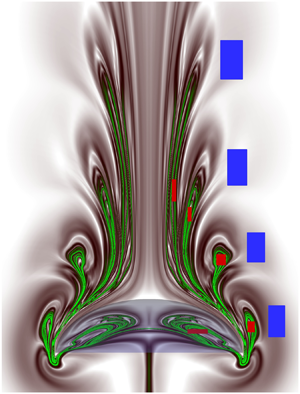Article contents
Kinetics and prey capture by a paddling jellyfish: three-dimensional simulation and Lagrangian coherent structure analysis
Published online by Cambridge University Press: 15 February 2021
Abstract

Three-dimensional simulations are performed to investigate swimming and prey capture by a paddling jellyfish. First, the three-dimensional vortex–vortex and vortex–body interactions are revealed, as the jellyfish swims forwards through several cycles of active muscle contraction followed by passive energy recapture via shape recovery. For varied transient paddling force and paddling frequency, we analyse the resultant changes of a jellyfish's swimming speed, interactive power, cost of transport and prey clearance rate. The pressure field around the periodically deformed elastic bell and the circulation generated by starting and stopping vortex rings are presented in greater detail to better understand the biophysical interactions that support swimming. Second, to reveal prey-specific interception and feeding behaviour, using a dynamical-system-based approach and modified Maxey–Riley equation, we compute the trajectories of the surrounding infinitesimal, inertial, opposite and normally escaping prey or plankton that hover around the medusa and are swept differently via the paddling-created velocity field. Accordingly, the diverse prey trajectories are obtained with varied paddling force, resonant driving of the elastic bell and for two different bell fineness ratios. These trajectories are then used to compute the finite-time Lyapunov exponent fields and identify particle Lagrangian coherent structures for various motile/strategically evasive prey, for five swimming cycles. The detected geometric separatrices unambiguously map and demarcate differently driven upstream fluid regions of a medusa and illustrate precisely from where an intercepted prey can be brought into the jellyfish bell, or safely stored in a capture region for ingestion, and from where a prey will surely escape. Hereby, for the first time, the prey-specific target regions, the physically well-defined three-dimensional capture surfaces and the generated cycle-to-cycle prey clearance rate are presented/analysed like never before, which provide a significantly advanced understanding on diverse predator–prey interactions and resultant success rate in prey capture. Several supplementary movies that show detailed fluid–structure interactions, transient entrainment of the floating prey and eventual prey confinement inside a secured capture surface are provided for two different jellyfish morphologies (fineness ratios 0.3 and 0.5) that help to better comprehend the natural prey encounter and hunting processes.
JFM classification
Information
- Type
- JFM Papers
- Information
- Copyright
- © The Author(s), 2021. Published by Cambridge University Press
References
- 11
- Cited by


